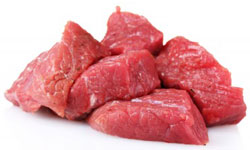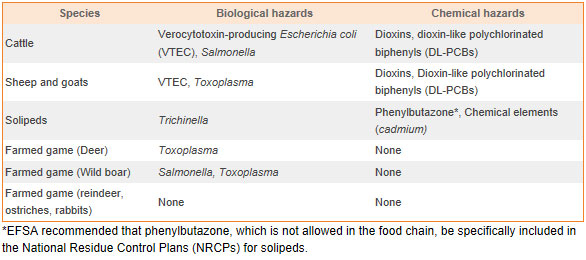EFSA completes review of practices and recommends improvements
- Like
- Digg
- Del
- Tumblr
- VKontakte
- Buffer
- Love This
- Odnoklassniki
- Meneame
- Blogger
- Amazon
- Yahoo Mail
- Gmail
- AOL
- Newsvine
- HackerNews
- Evernote
- MySpace
- Mail.ru
- Viadeo
- Line
- Comments
- Yummly
- SMS
- Viber
- Telegram
- Subscribe
- Skype
- Facebook Messenger
- Kakao
- LiveJournal
- Yammer
- Edgar
- Fintel
- Mix
- Instapaper
- Copy Link
Posted: 27 June 2013 | EFSA | No comments yet
EFSA has completed a major piece of work that will provide the scientific basis for the modernisation of meat inspection…


The European Food Safety Authority (EFSA) has completed a major piece of work that will provide the scientific basis for the modernisation of meat inspection across the EU. Following a risk based approach, EFSA has identified and ranked public health hazards in meat. As requested by the European Commission, EFSA has recommended improvements to meat inspection procedures to protect consumers from risks related to such hazards.
EFSA’s Executive Director, Catherine Geslain-Lanéelle, said: “This work will support risk managers in mitigating public health risks at an important step in the meat production chain”.
The four scientific outputs published today provide advice on meat inspection procedures in cattle, sheep and goats, farmed game, and domestic solipeds such as horses. These outputs follow two previous opinions on inspection of swine and poultry, published respectively in 2011 and 2012. Since then EFSA has assessed meat inspection procedures for a broad variety of meat-producing animals in the EU.
Traditional practices of meat inspection are not always suitable for detecting the main meat-borne hazards such as Campylobacter and Salmonella or contamination by chemical substances such as persistent organic pollutants or prohibited substances. For this reason, the European Commission decided that meat inspection practices in the EU should be modernised.
For all types of meat-producing animals considered, EFSA has identified foodborne biological and chemical hazards and ranked them according to their risk for public health.
For biological hazards, the priority ranking was based on assessment of their impact on incidence of disease, the severity of the disease in humans and evidence that consumption of meat from the various species is an important risk factor for the disease.
Risk ranking of chemical hazards was based on the outcomes of the National Residue Control Plans for 2005- 2010 and other testing programmes as well as substance-specific criteria, such as its toxicological profile.
For the most relevant foodborne biological hazards, EFSA has also proposed harmonised epidemiological indicators. The indicators will be useful in the context of the proposed comprehensive meat safety assurance system, enabling the categorisation of farms, flocks or herds and abattoirs according to potential risk and the setting of microbiological targets for carcasses.
EFSA scientific experts have recommended improvements to existing practices or alternative methods for the inspection of meat. EFSA’s experts also considered the implications of the proposed changes to current practices for surveillance of animal health and welfare.
To fulfil this complex and cross-cutting mandate, EFSA drew on its expertise in a wide range of fields within its scientific remit: biological hazards including zoonoses (animal diseases transmissible to humans), chemical contaminants in the food chain, animal health and welfare, and risk assessment methodologies and data collection.
- Scientific Opinion on the public health hazards to be covered by inspection of meat (solipeds)
- Technical specifications on harmonised epidemiological indicators for biological hazards to be covered by meat inspection of domestic solipeds
- Scientific Opinion on the public health hazards to be covered by inspection of meat from farmed game
- Technical specifications on harmonised epidemiological indicators for biological hazards to be covered by meat inspection of farmed game
- Scientific Opinion on the public health hazards to be covered by inspection of meat from sheep and goats
- Technical specifications on harmonised epidemiological indicators for biological hazards to be covered by meat inspection of domestic sheep and goats
- Scientific Opinion on the public health hazards to be covered by inspection of meat (bovine animals)
- Technical specifications on harmonised epidemiological indicators for biological hazards to be covered by meat inspection of bovine animals
ANNEX
Overview of key findings
Main biological and chemical hazards identified for each animal species


Recommendations applicable to all species
Biological hazards
- Introduce a comprehensive meat safety assurance system, including clear targets for main hazards in carcasses. New data on biological hazards might be needed to support such targets;
- To meet these targets, use the available control options for the main hazards, at both farm and abattoir level;
- Categorise herds/farms and slaughterhouses according to the magnitude of risk posed by biological hazards.
- Omit routine palpation or incision techniques in post-mortem inspection.
Animal Health and Welfare implications
- Meat inspection, which includes ante-and post-mortem inspections, is a valuable tool for surveillance and monitoring of specific animal health and welfare conditions.
- If only visual post-mortem inspection is applied, other approaches should be followed to compensate for the associated loss of information with regard to surveillance of animal disease and welfare conditions. A change to a visual-only post-mortem inspection would decrease the quality of surveillance for some animal diseases. In particular, surveillance of bovine tuberculosis will be adversely affected.
- Extended use of other information collected throughout the food chain could compensate for some, but not all, the information lost due to the proposed changes.
Contaminants
- Monitor chemical residues and contaminants based on risk of occurrence taking into account food chain information and prioritisation by level of concern.
- More flexible control programmes based on test results and open to new hazards.
- More integrated sampling, testing and intervention protocols for monitoring chemicals in the food chain and environmental contaminants.




